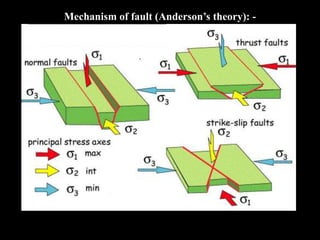Fractures
- 1. FRACTURES OF GEOLOGICAL ORIGIN Presented by Arvind Shukla M.Sc.(Applied Geology, 4th semester) Department of Earth and Planetary Sciences University of Allahabad, Allahabad, U.P. Email:-arvindshukla.au@gmail.com
- 2. INTRODUCTION In a rock fractures are the surfaces of weakness along which two blocks have tendency to move or break. Fractures are also defined as the separation of a body into pieces due to stress, at temperatures below the melting point. (Haakon Fossen, 2010). Penetrative and pervasive on the scale of observation. Developed mainly due to brittle failure in the rock. Forms as a result of external (e.g. tectonic) or internal (thermal or residual) stress.
- 3. IMPORTANCE OF FRACTURE 1. Conduits for the migration of fluids through solid rock. 2. Migration of groundwater, of hydrocarbons, and of hydrothermal and metamorphic fluids. 3. To know the tectonic evolution of the Earth's crust and the dynamic processes that drive that evolution. 4. Fractures often serve as the site of preferential weathering and thereby control the form of much of the Earth's topography. 5. Major impotence in the integrity of nuclear waste disposal sites.
- 4. 6. Affect the location of hydrothermal mineral deposits. 7. Provide a better understanding of the secondary mineral deposit along the joint planes. 8.Because the cohesion of the rocks is lost across fracture surfaces, they are planes of weakness in the rock. This inherent weakness must be accounted for in the building of dams, bridge abutments, tunnels, mines, and similar engineering projects. 9. To better understand where large earthquakes originate.
- 5. CLASSIFICATION OF FRACTURE There are two types of fractures classified into 3 modes- 1). Extensional Fractures: Mode-I (Joints) • Form when the adjacent blocks move away from each other in a direction perpendicular to the fracture plane. • Very often these fractures are cemented with minerals that precipitate from the solution filling the rock’s pore space. Quartz in silica-rich rocks and calcite in carbonate-rich rocks commonly seal the fractures. 2). Shear Fractures: Mode-II (Faults) • Involve displacement of adjacent blocks parallel to the fracture plane • Shear fractures exist at any scale from microns to hundreds of kilometers, and are often seismogenic (i.e. they are associated with earthquakes).
- 7. Fracture is a general term. It is mainly classified as Faults and Joints. FAULT •A fault is a fracture across which two blocks have slipped; the displacement of adjacent blocks is parallel to the fault plane. •Faulting corresponds to the brittle failure of an undeformed rock formation or, alternatively, involves frictional sliding on a pre- existing fault plane. •Faulting occurs when the maximum differential stress exceeds the shear strength of an intact rock formation or the frictional strength of a pre-existing fault.
- 8. FAULT TERMINOLOGY Fault plane, Footwall, Hanging wall, heave, throw, fault scarp, hade, ……..
- 9. TYPES OF FAULT 1. Normal Fault 2. Reverse Fault 3. Strike Slip Fault Normal Fault Source:https://www.google.com/bibikchatterjee/faultbibekfinal
- 10. REVERSE FAULT STRIKE SLIP FAULT
- 11. EVIDENCE OF FAULTING The most important evidences of faulting are:- A). Geological evidences:- 1. Repetition and omission of strata. 2. Offset of rock unit: - Displacement of rock bed, dyke, vein, etc. Occurs on opposite site of a fault. Offset of quartz vein. 3. Stratigraphic sequence B). Fault Plane Evidences:- 1.Feather joints 2.Slickensides-The movement of one block against another block result polishing and grooving of fault surfaces. These grooved and striations are called slickensides. Slickensides are useful to knowing the direction of the last movement on a fault surface.
- 12. 3). Fault Breccia and Gouge:- Angular grains are embedded in a finely grounded rock are called “faulted breccia, formed as a result of grinding and crushing movement along a fault. When the rock is broken into clay or silt size particles as a result of slippage on the fault, it is referred to as fault gouge. 4).Mylonite:-Along some faults rocks are sheared or drawn out by ductile deformation along the fault. The resulting rock is a fine grained show evidence of shear, called mylonite. Faults that show such ductile shear are referred to as shear zones.
- 13. Mechanism of fault (Anderson’s theory): -
- 14. JOINT A joint is a type of fracture surface of geological origin along which no appreciable displacement has taken place. In joint movement of adjacent block are essentially perpendicular to the fracture surface. Joint leads to the crustal extension. Joint usually developed in shallow part of the earth’s crust and are mostly associated with other deformed structure like fold and fault. Joint filling (Secondary Deposit)- •All materials occurring between the fracture walls are referred to as joint filling. •The secondary deposit along joints are dilational, if the vein material occupies space between the two original fracture surfaces, or non-dilational if the vein material occupies space made available by replacement of the original rock outside the two original fracture surface.
- 15. Joint related terminology I. Joint Set:- A group of parallel (similar orientation ) or sub-parallel joints. II. Joint system:- A joint system is formed when multiple or differentially oriented joints sets cross each other. III. Master Joint:-A joint which extent over long distances. Classification of joints- 1.Based on orientation of joint set- i. Orthogonal joints ii. Diagonal Joints 2.Based on nature of filling- - Filled and unfilled 3.Based on angular relation of joint set- i. Shear joint ii. Extensional joint iii. Oblique joint
- 16. Joint associated with fold:-
















